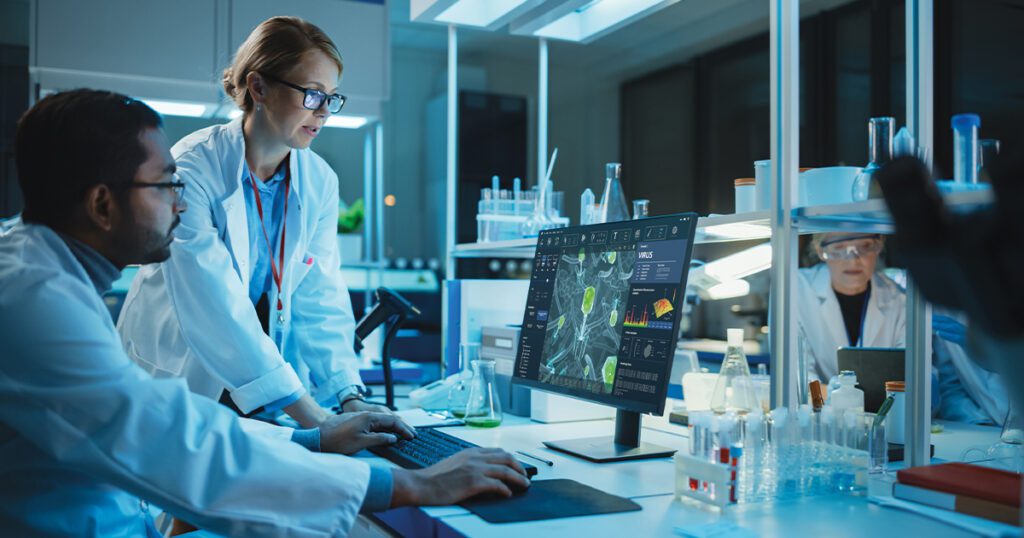How digital transformation helps Life Sciences firms drive drastic increases in product and process visibility
Digital transformation in the Life Science industries is at an inflection point. A convergence of unique events, like the COVID-19 pandemic, and technology-related trends, such as recent breakthroughs in digitized research and manufacturing, have dramatically accelerated and advanced corporate digital agendas.
As a result, those companies looking to establish a more decisive competitive advantage are now actively changing how they approach their digital transformation strategy.
Many organizations recognize the degree to which their paper-based operations and siloed data capture constrain their ability to respond to rapidly-changing marketplace demands. The pandemic forced radical changes to standard operations. The ability to capture, consolidate, and rapidly analyze data has emerged as a critical success factor impacting regulatory compliance and profitability.

Compartmentalized data creates barriers to information exchange
Existing data silos are problematic because research and development and engineering design data are challenging for process line manufacturing stakeholders to access. On the manufacturing lines, the numerous types of equipment are often maintained by entirely different teams of engineers. It becomes difficult, costly, and time-consuming in such environments to blend the data created across these various “islands.”
The data silos also make it complex to communicate back to the regulators demanding evidence that a highly controlled production environment is being maintained. With vast quantities of data being generated from many isolated systems – such as research, production, and quality control − visibility of how that data impacts production efficiency, and product quality is limited.
Maximizing business value through digital transformation-enabled data control
True digital transformation is about developing the capabilities of capturing, blending, and contextualizing data. It then enables that data to be quickly accessed and used by multiple organizational stakeholders.
Building data ontology (the ability to discern the properties of the various pieces of data and the relationships between them), building a data hierarchy, and designing a data architecture based on a consistent set of rules and governance all help to maximize the business value of the data that daily operations generate.
Creating accessibility through digital transformation
The ability to capture and analyze data should also extend to life sciences operations’ contracted manufacturing. For example, from a regulatory standpoint, questions that pertain to drug ingredients, where those ingredients were sourced, and when the drug was produced need to be quickly answered — even if the drug in question has been manufactured via third-party contractors.
The data must also be managed beyond just one plant within one geography. Enterprise-wide data must account for variations across multiple plants and global regions where regulatory statutes may differ.
Logical areas to accrue benefits through digital transformation
To achieve the goals of high visibility and flexible operations, life sciences firms have launched digital transformation initiatives designed to help drive faster and more accurate business decisions.
Below are several examples of areas where significant digital transformation-based improvements are taking place:
Data transparency
In the life sciences industries, traceability for safety reasons is critical to regulators and the customers who consume the manufactured drugs. Pharmaceutical firms are tasked with assuring that the drugs they manufacture are identical regardless of where they are produced.
Making these drugs completely replicable across all environments requires clear visibility into the details of laboratory and manufacturing operations. Digitization of operations in a way that facilitates this high level of traceability can now be accomplished through the right combination of digital services, artificial intelligence, and analysis software.
Such tools enable real-time feedback on an ongoing basis. In addition, since levels of connectivity increase dramatically in such scenarios, cyber security becomes a critical success factor for protecting digitized operations.
Workforce training
During the intense rush to roll out COVID-19 vaccines, major drug manufacturers were forced into an “all-hands-on-deck” emergency work approach.
Though temporarily successful, such an approach is not a tenable long-term strategy. The pandemic only exacerbated the issue of experienced labor shortages. To address this issue, and to empower new, inexperienced employees with the correct information to guide them in their tasks, tools such as “digital twins” have emerged as a realistic and affordable option.
Digital twins
A digital twin is a virtual software model that analyzes data and uses it to run simulations and benchmark performance. This allows plant operators to pinpoint where efficiency gains can be made. By pairing both virtual and physical worlds, data analysis and monitoring of systems can actively avert problems before they occur, preventing downtime and developing new efficiency opportunities.
In the case of the life science industries, the new workforce is empowered to work in augmented reality (AR) and virtual reality (VR) training environments, confronting and addressing problem scenarios without causing damage or disruption to existing operations. Those types of AR-VR tools are then expanded to places like engineering design and manufacturing production environments.
Sustainability
Mastery of both product and process data enables better quality of output. In some cases, batch processes can affordably be converted to continuous processes, increasing output delivery while boosting output volumes.
Such changes also create a beneficial ripple effect of minimizing waste while enhancing sustainability in business processes. When manufacturing a better-quality product consistently, operations inevitably save energy. This is a critical criterion in the production of higher-sustainability drugs.
The increased flexibility in operations also enables the reuse of formerly only single-use process materials− like bioreactor processes that traditionally deployed only single-use/throw-away bags.
For more information
Companies like Schneider Electric support Life Science industry digital transformation projects through best practice sharing and the lessons learned from our internal manufacturing operations and the many global customer projects we support. In fact, our Global Supply Chain organization has been recognized for its 200 worldwide newly digitized smart factories and been ranked #1 in the 2021 Gartner Supply Chain top 25. Familiarity with core digitization elements – such as open systems, digital twin software tools, building management, advanced process control and data gathering, consolidation, and analysis tools – helps us to minimize risk and maximize success when deploying digital transformation projects.
Sustainability is also central to the way we operate. Corporate Knights, the world’s largest-circulation magazine on clean capitalism, in 2021 named Schneider Electric the #1 sustainable company on their Global 100 index. Sustainability is a journey that we accomplish with our innovations, people, partners, suppliers, customers and communities where we operate.
We help our Life Science clients to design an energy strategy, deliver efficiency in their facilities and sustain results over time through long-term partnerships. With a broad and comprehensive portfolio of software apps, analytics software and asset and microgrid management services, we help our clients to lower business risk, increase operational resilience, and drive growth while quickly adapting to marketplace changes. As an unbiased, independent consultant, we work with clients in more than 100 countries; from regional companies to the world’s largest corporations.
To learn more, access our Life Sciences website or download our new e-book “Turning risks into opportunities for Life Sciences.”

